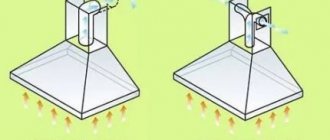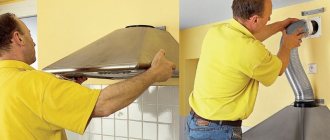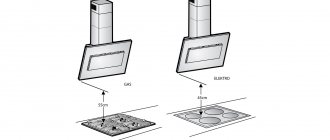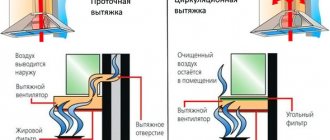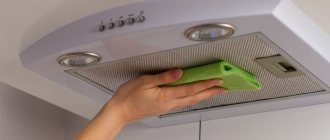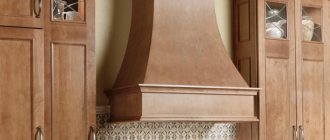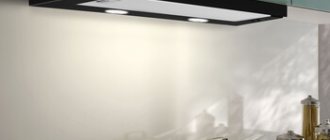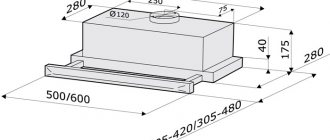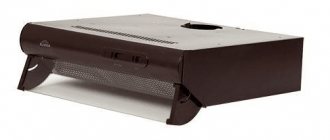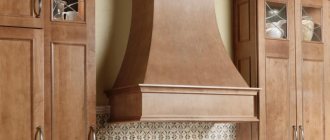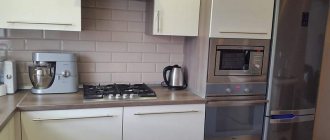What is a recirculating hood
There are three types of ventilation systems for kitchens: natural, forced and combined:
The first involves ventilating rooms due to natural draft, which ensures the movement of air from slightly open windows (slots, special supply valves) to the ventilation ducts. Natural and forced ventilation
The forced system operates thanks to the operation of energy-dependent devices responsible for the influx and removal of air masses.
The combined version combines the spontaneous influx of air masses with forced removal through the hood.
All these solutions can only be implemented if it is possible to connect to a ventilation shaft. If this is not possible, an excellent solution would be to use a recirculating hood - a device that does not pump air from the kitchen into the ventilation duct, but returns it back cleaned and filtered.
The standard device consists of the following elements:
- Frame.
- Fan. Draws air in. There are models with one or two fans. They are located above the filters or between them.
- Engine. Drives the fan and is powered by a standard electrical outlet.
- Set of filters. Passing through them, the air is cleansed of impurities, odors, etc.
It’s worth looking at filters in more detail. It is these elements that are responsible for the quality of cleaning the air passing through the device.
As a rule, the hood is equipped with several filters:
- Anti-fat. It is a fine mesh or metal lattice. The filter is not a serious obstacle to odors, but it traps the smallest particles of fat rising with steam very effectively. Needs regular (every 20-40 days, depending on the intensity of use) cleaning. The filter can be rinsed in water using non-abrasive detergents.
- Carbonic. A round or rectangular plastic cassette filled with granules of carbon powder. Detains small particles that have passed through the first filter. Effective against kitchen odors, completely safe for health.
Note! The filter is a consumable item and must be replaced every 3-5 months. Original or universal filter models are available for sale. The latter are cheaper, but have a shorter service life.
The hood is often equipped with a filter status indicator, which helps to replace these consumables in a timely manner.
What types of hoods are on sale?
According to the principle of operation, exhaust equipment can be divided into two categories:
- Flow hoods. They are also called tap-offs. This type of device discharges exhaust air into the home ventilation system or directly to the street through an air duct pipe. Moreover, it is possible to use an external outlet only if there is a special exhaust duct. If the hood is ducted into the ventilation system of a house with a common ventilation shaft, then the equipment most likely simply will not be able to function correctly, since old systems do not provide for such loads. For this reason, if you decide to install a vent hood in your apartment, the best solution would be to vent it to the outside.
- Recirculation hood. You can also hear names such as carbon, filtration, etc. A device of this type does not require the presence of an air duct. It collects polluted air, places it in an internal tank and cleans it using a filter system. Typically, such equipment involves two stages of purification. First, rough processing occurs, during which dirt, grease and soot are filtered out. The air is then cleaned of unpleasant odors and then returned to the room.
USEFUL INFORMATION: How to remove old tiles from bathroom walls
When to install a kitchen hood without an air duct
Installing a supply hood is not always possible or advisable. The reasons are varied:
- The location of the hob at a distance from the ventilation duct requires either the construction of an air duct, which disfigures the room, especially if it is a studio apartment.
- Centralized ventilation is absent or does not function properly.
- If a gas water heater is used in the kitchen, supply systems are dangerous because back draft can be created in the ventilation shaft.
A recirculating exhaust device remains the preferred, and sometimes the only, option in these situations.
It is important! The recirculation unit also needs a supply of fresh air. Passing through the filters, the air does not become fresher, it is only cleansed of unwanted odors and impurity particles.
Design and principle of operation of a hood without air ducts
A standard kitchen device is essentially a fan that draws in air and forces it into the duct. And if it is in a private house, then - on the street. This is a hood with a ventilation outlet.
A hood without discharge is not connected to the air duct. It is not a ventilation product, but a circulation product. In this case, the air is not removed from the kitchen, but is filtered and released indoors.
In this regard, such devices are called recirculating hoods. The housing uses a two-stage filtration method. Seeping through the filters, the cleaned air is not removed into the well, but goes back into the kitchen.
It is blown out through holes located in the front or side of the device body. Sometimes hoods without an air duct have boxes with holes on top, and then filtered air flows only to the ceiling of the room.
And in other cases, such products have the same operating principle as traditional ducted hoods. There are two types of devices: mechanically and electrically controlled. Electrically driven devices may have touch or push-button coordination.
The model with a mechanical mode has a slider with which the power is turned on and adjusted. Hoods with mechanical control are slightly cheaper than those with electric drive.
Operating principle of flow and circulation hood
Types of hoods depending on mounting
A significant factor when choosing an exhaust device is the installation of the product. The best option would be to purchase furniture and equipment at the same time. How do products differ depending on location?
They come in three main types:
- Hanging models. The advantage of wall-mounted products is that they are suitable for any small kitchen. The hood is fixed exactly above the stove and performs its tasks with the help of carbon filters. Due to this location, an additional kitchen cabinet is often installed above it instead of an air duct.
- Built-in hoods. The device is mounted in a cabinet, which is hung above the stove. Such products are more efficient in performance, as they have a retractable panel. With its help it is easier to regulate the ventilation process. The built-in model has a metal filter that does not need to be changed, just wash it.
- Dome devices. They are fixed to the ceiling and can be placed at intervals from the kitchen wall. Previously, similar products were used in restaurants and cafes, but now the domed model can be found on the market, in different sizes and designs. Today there are hoods made of wood, metal, glass and other materials.
How a hood without air ducts will work in principle does not depend on each individual location, but the advantages of such devices are obvious.
Built-in hood in the kitchen
Which type is better based on installation method ↑
Both flow and circulation devices can be installed in various ways, depending on the location of fixation and design features. Hanging appliances that were once the most common are suitable for a standard kitchen set. Their place is above the stove, under a shelf or a small cabinet. The hood is completely visible, but takes up little usable space.
Nowadays, embedded technology is increasingly being used. It is more productive and looks much more attractive: the working mechanism is hidden in a cabinet, and only the beautiful lower surface with a control panel on the front side comes out. The cabinet is not fake, since the technical filling occupies a small part of it, and the rest of the space is suitable for storing dishes or bulk products.
Built-in hood in a classic interior
The latter type also includes corner solutions, specially made for hanging in a corner. Their choice is small, because the corner is not the best place to install a hob, and therefore there is no active demand.
Corner model in the interior
Along with wall-mounted kitchen hoods without an air duct, there are island hoods, which cannot be avoided if the work surface with the stove is moved to the middle of the room, to the so-called “island”. Autonomous devices do not require suspended ceiling structures to mask communications, which is why many choose them.
Island hood in a modern style
What types of models are there?
There are only two types of recirculating hoods: a flat model and a built-in hood, which differ slightly from each other, but have some distinctive advantages.
A flat hood without connection to ventilation has a larger body panel, an internal fan and a filter system; it is compact in size compared to the classic dome model and takes up less space in the kitchen. At the same time, the work of such a hood is decent: it sucks in air and filters it from small particles of plaque, fat, odor and releases it back. This model is installed under a kitchen cabinet; it is important that there is an outlet near the hood.
The built-in model of the circulation hood has the same “filling”, but it is installed in the kitchen cabinet, leaving only the elegant control panel exposed to the eye. By the way, it is not necessary to purchase a separate cabinet for the hood; it can be “hidden” thanks to an additional model in the main color of the kitchen. The telescopic system has become especially popular, which allows you to extend the hood for work and push it back to complete the air intake.
Each of the models is available in sizes 50 cm and 60 cm, that is, suitable for “integration” into a standard-sized wall kitchen cabinet.
Principle of operation
Operation of hoods with exhaust and circulation modes
A kitchen hood without an air duct is equipped with a motor that drives the fan and turns on the cleaning units. Thanks to the fan, a draft is generated in the system, which helps suck out harmful fumes from the kitchen.
Most modern models can operate in several modes - exhaust and circulation. Each of these modes directs polluted air to different locations.
The exhaust mode drives air to the ventilation shaft or to the street. This is achieved thanks to special clamps connecting the air duct.
The operation of the circulation mode is to clean dirty air and return it to the room.
Advantages and disadvantages
There are different opinions among consumers regarding the use of a kitchen hood without an air duct: some are exclusively against such equipment and call it “useless” in the kitchen, while others prefer modern models of hoods with carbon filters and a recirculation system.
Let's talk about the features of such hoods in order to form a preliminary opinion about their work:
- A hood without a pipe does not interfere with air circulation in your kitchen and apartment as a whole, since the hole where the air vent is usually installed is free. With an alternative system of operation of the hood, when the air vent is installed in accordance with all the rules and regulations, but the hood is not turned on, the passage of air is difficult.
- The recirculation unit is light in weight and small in size, which makes it easy to purchase the model you like and bring it home without selecting additional equipment such as labor and fastening structures. A compact and lightweight hood without an air vent can be stored in any part of a small apartment and not interfere with the completion of renovations.
- Installing this model is simple: the hood is mounted in a cabinet (where there is no bottom shelf) using simple tools and connected to the electrical power supply system. There is no need to purchase additional adapters.
- The pricing policy for recirculating hoods is lower than traditional dome hoods and others that have an air vent. Of course, the price per unit of the hood depends on the brand and its characteristics: size, power, set of functions.
- Caring for the hood is reduced to a minimum of effort: it is worth wiping its visible surface (panel) and promptly changing the filters inside. By the way, you may need to replace the light bulbs on its panel, or the hood lighting, and this is done extremely simply.
- A couple more words about the filtration system: it consists, as a rule, of two types of filters: carbon and metal. Coal ones are changed much more often than the latter; after 3-6 months they are simply removed and thrown away. Metal filters can be washed - remove the accessory and rinse under the tap or put in the dishwasher.
- A hood without a bulky pipe for air exhaust is ideal for a small kitchen or a room where installing that same pipe would be much more expensive and difficult (impossibility of installation, loss of attractiveness of the room). Often, an air recirculation system hood is chosen for a kitchen interior in a minimalist or high-tech style, when it is necessary to maintain a laconic atmosphere and rid the space of unnecessary details such as pipes.
Now let’s note the possible disadvantages of the electric hood model:
- Replacing filters in a hood without an air vent is a task that requires execution in order to avoid disrupting the operation of the air purification system. Some may find this an expensive procedure, others will note the unnecessary obligations for themselves and prefer the traditional model. But if it breaks down, it is easier to inspect a small recirculation model for damage and repair it than to understand a large hood and its pipe in search of an answer to your question.
- There is an opinion that a hood with recirculation does a worse job of cleaning the air in the kitchen, especially in intensive cooking conditions. This opinion is extremely incorrect; it is important to follow the regime for replacing its filters and install the structure correctly - lower to the hob.
- The design of a hood without an exhaust hood is monotonous - a rectangular, often horizontal design, without a fan and the ability to further transform the kitchen interior. The hood panel can be as narrow and thin as possible; the model can be a hood with an element made of heat-resistant glass or have a familiar design. You can “play” with the color of the hood – white, metallic, glossy or matte. The hood model is considered the most original of the presented range.
- Reviews about recirculation system hoods are mixed; some are satisfied with their choice, while others would prefer a traditional model. You should get used to such an air exhaust system and enjoy it as a modern way of cleaning your kitchen from unpleasant and unnecessary odors when cooking, and when choosing, pay attention to a trusted brand and a good installer who will allow the model to be functional.
Flaws
- Ductless kitchen hoods have carbon filters that cannot be cleaned once they become dirty. Therefore, they must be periodically replaced with new ones, which leads to additional costs. At the same time, many are interested in the question: how long does one carbon filter last? In fact, its service life depends on many factors: the number of people in the family and the frequency of use of the hood. In addition, if you frequently cook fatty fried foods, the filters become clogged faster. On average, one filter lasts for 3-6 months. However, some modern models of flow hoods are also equipped with filters that require periodic replacement.
- Manufacturers of ductless hoods produce them in a small variety of designs. Most often they have noble simple forms and laconic images, while flow-through models are made in a variety of options: from the most modest to luxurious fireplace ones.
Types of hoods without duct for the kitchen
These models are not very diverse. There are only 2 types of recirculating hoods: one that is made in a very flat body, and one that is built-in. They are not much different from each other, but still have some distinctive advantages.
Flat body electric coal models
It features a larger housing panel, an internal fan and a filter system. It is very compact compared to classic dome ones. Takes up less space in the kitchen, making it ideal for small spaces. But despite its small size, the system has excellent performance. It filters the air from various plaque particles, grease and unpleasant odors. And then it releases the air back into the room. Its installation is quite simple. The device is placed under kitchen cabinets - air removal is better there. But it is important to consider that there is an outlet near the installation site.
Built-in model
The second type is built-in technology. It has the same filling. The difference is that installation is carried out in a kitchen cabinet - only the control panel can appear in front of the household. Both of these models can be purchased in sizes of 50 or 60 cm. These dimensions were not chosen by chance, since they are specially calibrated to fit into the standard size of a kitchen cabinet.
Types of hoods for kitchens without an air duct
Flat inclined hood without duct
It is not possible to install a standard hood everywhere. For example, in a private house this option is not suitable, since there is no ventilation outlet. For such cases, there are two types of ductless hoods.
Flat
It is a device that consists of a fan, a housing panel and a filter. It can be vertical and horizontal. The main advantage is its compact size. Thanks to this, the device fits perfectly into any interior. Modern models are made of glass, aluminum and chrome.
Built-in
Built-in modifications without an air duct are devices that are closed with wall cabinets or special panels. The most popular is the telescopic system. Its convenience lies in the fact that at any time you can pull out the equipment for work and then remove it from prying eyes.
Advantages and disadvantages
There are different opinions regarding the purchase of these hoods. Some users are negative about this technique because it does not have an air duct. It is often called useless in the kitchen space. Other people consider such models to be very modern, with a reliable filtration system, which, in their opinion, replaces the air duct. It's worth talking about their positive qualities so that anyone considering buying a ductless hood can make the right decision.
pros
So, the positive characteristics:
- The air circulation in the kitchen and in the house is not at all impaired due to the absence of an air duct in the hood, since the holes through which the air duct is usually installed are always free. And if the equipment is installed according to all the rules with a pipe, during shutdown, the passage of air, on the contrary, can be difficult.
- The system without an air duct is very light in weight and also very miniature. This allows you to easily buy this model and bring it into your home yourself, without spending a lot of money on delivery. It also does not require any additional equipment in the form of pipes or any structures for fastening.
- It can be located in absolutely any part of the kitchen, and it will never get in the way due to its large volumes.
- It's very simple. It is installed in a cabinet, and then connected to the home’s power supply system with a simple tool. This electric range hood is amazing for the kitchen. Another advantage is that you do not need to purchase any additional adapters.
- A positive point is the price of the structure. These types are much cheaper than traditional ones that have an air duct. Of course, the price will also depend on the manufacturer, its brand and characteristics. But when compared with traditional models, they have a much lower cost.
- The device also does not require any specific or special care. You just need to wipe it from dust and change the filter elements on time. Sometimes it may be necessary to replace the light bulbs on the panel, but this is very easy to do. No more difficult than changing a light bulb on a chandelier.
- The filtration system on these models is very good. As mentioned above, filtration elements consist of two parts: metal and carbon. Carbon ones will have to be replaced more often than metal ones, but the advantage is that they are very easy to remove. A positive property of metal filters is that they can also be easily dismantled and washed with water, after which they can be put back in place. The metal filter can also be easily placed in the dishwasher for quick cleaning.
- A system that does not have a large exhaust pipe may be suitable for a small kitchen. It is also suitable for a room where installing a bulky pipe structure can be costly. The air duct can disrupt the appearance of the room. Such an exhaust hood without a bulky pipe will solve this issue, and the removal of dirty air will be just as effective. This type of hood is installed in apartments where the style of minimalism or hi-tech reigns. Because the equipment has very laconic forms and does not take up much space.
Minuses
A system without an air duct also has its disadvantages:
- Replacing filters is a prerequisite for long-term operation of the equipment. The filters must be constantly monitored to ensure that the air purification system does not fail. Some people may think that constantly replacing filters will cost a pretty penny. Another type of people thinks that such a technique imposes unnecessary obligations, and therefore they would rather choose traditional ones, which are much simpler, in their opinion. But the pros are still more significant than the cons. Due to its small size and simplicity, the equipment can be easily repaired in case of breakdown. Repairing a traditional hood will cost much more.
- Some believe that a system that does not have an air duct copes much worse with its direct responsibilities in the kitchen. But this opinion is fundamentally wrong. You just need to monitor the condition of the filters, and its operation will not be disrupted. And in terms of performance characteristics it is in no way inferior to the traditional model.
- The design of the system is uniform, it has a rectangular shape. The design is most often horizontal. There is no way to somehow decorate your kitchen using such hoods. You can diversify the design only by choosing a color, which is available in large quantities. But this is a very minor drawback, because it serves to purify the air, and not for decorative elements.
- The ductless system has mixed reviews. Some people are happy with the choice, while others prefer the traditional model. You just need to get used to it, since it is a very modern air purification system.
How to choose the right electric one without venting to ventilation
In order not to make a mistake when choosing and purchasing a ductless hood for your kitchen, you need to take into account many factors, the main ones being:
- Required hood power, which depends on the size of your kitchen.
- The appearance , size and shape of the hood, the correct choice of which will allow the hood to fit harmoniously into the interior of your kitchen.
Power and type of electric hood
Before choosing a kitchen hood, you first need to determine its required performance, which depends on the volume of your kitchen. To calculate productivity, you need to multiply the area of the room by its height, as a result of which we find out the volume of the kitchen, then multiply the result by 10 or 12. This is the number that is equal to the required power of the hood for the kitchen. Find out which dishwasher is better and how to choose the right dishwasher here.
When purchasing a range hood, it is better to choose a model that has an adjustable power range, which will give you greater control over its operation. It should be noted that the parameters of a hood without an air duct must correspond to or be no less than the dimensions of the oven hob.
You need to know that a small room does not need a hood with maximum power, since the greater the power of the hood, the more noise it makes during operation. Today, the optimal indicators for exhaust power are three hundred to six hundred cubic meters per hour.
Filters: replaceable carbon, grease filter
Ductless hoods contain two types of filters:
- replaceable coal , the function of which is to purify the air from odors, smoke, burning, soot, fumes;
- grease-catching cassettes , which are designed to cleanse the air of grease;
The principle of operation of a hood with such filters is the constant circulation of air (flat circulation) without a pipe, which is cleaned and released back into the room.
It must be remembered that these filters must be replaced regularly at the intervals specified by the manufacturer in the technical specifications of the hood.
Housing surface material
The material from which the hood body is made significantly affects its appearance, and, naturally, the cost. If you have false beams installed, then it is advisable to select a hood to match it. Today, the following materials are used in the production of hoods:
- metal (aluminum, stainless steel);
- enamel;
- strained glass.
Hoods made of stainless steel and aluminum are practical and have an impeccable appearance. Such hoods will decorate any interior.
The most inexpensive material for a hood body is enamel, which is a durable material. This electric hood body is easy to clean, and this process does not require the use of special detergents or special effort.
Tempered glass hoods have a stylish and sophisticated look. But such hoods require difficult special care, as well as careful handling.
Thus, each material from which hood bodies are made has its own advantages and disadvantages.
Additional functions
Filtration hoods offered today on the household appliances market may have additional functions. Here are some of them:
- lighting, the functions of which are not only to illuminate the work area, but also to complement the kitchen design;
- automatic switching functions, in which the hood automatically turns on when the hob is in operation, and switching off;
- remote control of the hood, which allows you to operate it using the control panel;
- indicator of contamination of hood filters.
It must be remembered that the more functions a hood has, the higher its cost.
View tips on how to choose a hood for your kitchen:
How to choose a carbon exhaust system?
To make the right choice, you should pay attention to several key points:
- It is necessary to correctly calculate productivity. To do this, you should multiply the area of the kitchen by its height, then multiply the result by 12. The resulting number will be the required value.
- More is not always better. For a small kitchen it is better to choose a compact hood. This solution will both save on energy bills and reduce noise levels in the kitchen. Large exhaust systems are often quite loud.
- If you are interested in purchasing a low-noise hood, when purchasing, focus on the noise level not exceeding 40 dB. For example, sounds of 70 dB are comparable to a loud conversation at a distance of 5 meters.
- It is worth giving preference to models with power control. A larger range will help to better configure the system.
As with the purchase of any piece of furniture, the appearance of the air purification device in the kitchen must be selected based on your own tastes and needs.
Devices made of tempered glass have an elegant appearance, but before purchasing them, it is worth considering that they require careful handling and require special care.
Rules for choosing a hood without an air duct
A kitchen hood without an air duct is installed in apartments where the gas stove is located at a large distance from the ventilation system. They are suitable for old private houses with poor or no ventilation. The following principles will help you select household air purification equipment for kitchens without an air duct.
When choosing a hood without an air duct, it is necessary to correctly calculate the performance
- It is necessary to choose a device with a certain performance. It is calculated as follows. The volume of air in the kitchen (the product of the length, width and height of the room) is multiplied by the sanitary air exchange rate, which is equal to twelve. The calculated value shows the required performance of the exhaust device.
- Large equipment requires significant energy consumption.
- You should pay attention to the noise level of the hood. These data are indicated by manufacturers in the technical specifications. A figure greater than 40 dB means that the hood is noisy.
- It is better to give preference to equipment with a wide variety of control modes, this makes it possible to more accurately fine-tune the operation of the hood.
There are not only classic steel models on the exhaust equipment market. A kitchen hood without an air duct can be made of wood, plastic of different colors, metal ceramics or aluminum. The model can be selected to suit any kitchen design.
Chrome and glass models look very status.
More expensive luxury models of exhaust equipment have useful additional functions:
- automatically adjust to changes in the microclimate of the room (changes in humidity and air temperature);
- have filter contamination level indicators;
- equipped with an automatic switch-off and switch-on system;
- have a continuous and periodic operation mode;
- more powerful remote controls help control the operation of the device from the most remote points of the room.
Manufacturer's choice
There are many devices on sale from different manufacturers, the most popular among them are:
- HOTPOINT ARISTON. The products of this company are famous for their quality and reliability.
- CATA. Characterized by durability and stability.
- BOSH. The huge range of exhaust devices from this company is popular and has proven itself to be the best.
- VENTOLUX. The main feature is the introduction of the latest technologies into products.
- ELECTROLUX. They are famous for their individuality, variety and excellent appearance.
USEFUL INFORMATION: Siphon for sink with overflow
Each of these manufacturers has held leading positions in the market for many years, both in Russia and abroad.
What to look for when choosing
To choose the right circulation hood, you need to devote some of your time to familiarize yourself with the main parameters of this technique:
Dimensions
The device should not be smaller than your stove. It would be better if its dimensions slightly exceed the dimensions of the cooking surface.
Performance
The higher this indicator, the more air the hood can clean in 1 hour. It is considered normal if the air in the kitchen is replaced 12 times. To determine the required hood performance, you need to know the dimensions of the kitchen. The total area is multiplied by the height of the ceilings, and then multiplied by 12. For example, if the area of the room is 9 square meters, and the height of the kitchen is 3 m, then we get the required power: 9 x 3 x 12 = 324 cubic meters / hour. This indicator is the minimum power of the hood suitable for installation in a given room, which is recommended to be increased by 30 percent.
Note: If the kitchen is combined with some other room, then the total area of such a combination is taken into account.
Speed adjustment
A high-quality recirculating hood for the kitchen should have at least 3 speeds to ensure ease of working with different vapor intensities.
Backlight
This is a very convenient addition that allows you to illuminate the hob. LED lamps are preferable as lighting elements.
Review of popular models
The leaders in sales of household appliances on the Russian market are traditionally the brands Bosch, Electrolux, and Ariston. Manufacturers Gorenje, Samsung, Zanussi, Kaiser, ARDO are very popular, offering high-quality equipment not only premium, luxury, but also economy class.
The price range of offers is striking in its range from 3 to 170 thousand. The average price segment can be defined as around 10-20 thousand rubles, depending on the brand.
Ceiling hood Smeg KSC90B premium
The rectangular shape, flat volume, original materials and lighting make this hood “invisible”, which allows it to fit into any interior.
The device is intended for large rooms:
- declared capacity 830 cubic meters. m per hour;
- width 90 cm, it is possible to include work around the perimeter;
- electronic remote control;
- 4 speed modes;
- availability of interval operating mode;
- approximate price 140,000 rub.
Under-counter hood FALMEC Downdraft 600 120 WH
A very large hood designed for countertop mounting. Innovative high power model. When assembled, it is recessed under the table top.
Characteristics:
- declared productivity 960 cubic meters of air per hour;
- electronic touch control, plus remote control;
- 4 operating modes;
- 2 types of filter;
- timer;
- price – 160,000 rub.
Faber Zoom Isola XA 40 – compact model with great potential
The hood in the form of a ribbed cylinder 40x40 cm has a high throughput, reduced noise level and is intended for small kitchens.
Characteristics:
- capable of cleaning up to 830 cubic meters. m/h;
- electronic control system, remote control;
- 3 engine speeds;
- the presence of an intensive mode;
- filter status indicator;
- timer;
- backlight of 3 lamps;
- price 75,000 rub.
Best Moon BK 50 – a stylish solution
Island model, stylized as a ceiling lamp.
Main characteristics:
- standard air intake area is 50 cm;
- possibility of peripheral cleaning of the room;
- cleans 550 cubic meters m of air per hour;
- 4 speeds;
- 2 filters;
- touch-type electronic control system;
- approximate price 40,000 rub.
Miele DA 7090 W BK – wide fireplace hood
A stylish, high-power model looks natural at home and in an expensive living room.
Main characteristics:
- width 100 cm;
- volume of purified air per hour – 550 cubic meters. m;
- 3 speeds;
- filter status indicator;
- intensive work mode;
- adjustable backlight;
- electronic control, sensor;
- price about 90,000 rub.
